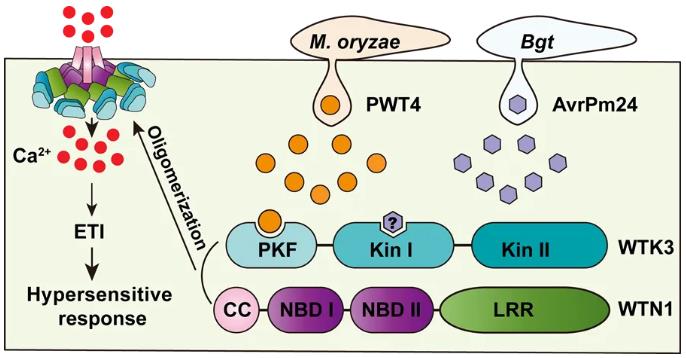On March 28, 2025, Zhiyong Liu's team and collaborators from the Chinese Academy of Sciences published a research paper titled "A wheat tandem kinase and NLR pair confers resistance to multiple fungal pathogens" in Science. This study revealed a new immune mechanism for tandem kinases to resist pathogen invasion: an atypical NLR protein WTN1 and tandem kinase WTK3 synergistically recognize the effector protein of pathogens to stimulate immune response, showing resistance to a variety of wheat fungal diseases.
This work breaks through the understanding of the mechanism of action of tandem kinases in the field, discovers a new paradigm of tandem kinases and traditional NLR synergistic disease resistance, fills the gap in the immune regulation pathway of plant tandem kinases, and lays a theoretical and application foundation for the precise design of broad-spectrum and multi-resistant varieties of crops.
Tandem kinase proteins (TKPs) are a new type of disease resistance protein discovered in wheat and barley in recent years. They are composed of two or more kinase domains in series, and show resistance to stripe rust (Yr15), leaf rust (Lr9), stem rust (Rpg1, Sr60 and Sr62), powdery mildew (Pm24, Pm36 and Pm57), wheat blast (Rwt4) and smut (U8), respectively, and have important breeding value. Zhiyong Liu's team previously cloned the broad-spectrum powdery mildew resistance genes Pm24 (WTK3, Nature Communications, 2020) and Pm36 (WTK7-TM, Nature Communications, 2024) encoding new tandem kinases from Chinese wheat landraces and wild emmer wheat, respectively. However, there are many unresolved scientific questions about new disease resistance proteins such as tandem kinases, such as how do tandem kinases recognize pathogen effector factors (Avr)? What roles do different kinase domains of tandem kinases play in crop immune responses? Through what immune pathways do tandem kinases activate crop disease resistance?

Figure 1. Working model of WTK3-WTN1 molecular module. (Lu, et al., 2025)
The team screened EMS-induced susceptible mutants of the powdery mildew resistance gene Pm24 (WTK3) and identified a key factor in the WTK3 disease resistance pathway, WTN1, which is an atypical NLR protein closely linked to WTK3. Genetic analysis results showed that the presence of WTN1 is the key to WTK3 immunity to wheat powdery mildew, and WTK3-WTN1 activates immune responses through a sensor-executor synergistic mode. Surprisingly, WTK3 is not only resistant to wheat powdery mildew, but also can recognize the wheat blast effector PWT4 and trigger an immune response, and has potential resistance to wheat blast.
The research team used a variety of methods such as plant immunology, biochemical experiments, electrophysiological experiments and evolutionary analysis to find that the WTK3 and WTN1 genes in wheat formed a close cooperative relationship during the evolution process, helping wheat resist the invasion of pathogens. Specifically, WTK3 has two important "functional modules". The first module consists of the pseudokinase fragment (PKF) and the first kinase (Kin I) domain of WTK3, whose task is to recognize the "attack signal" released by pathogens - the effector protein. The second module is the second kinase (Kin II) domain of WTK3, which is to connect the NLR protein WTN1 to form a "defense squad". When the invasion of pathogens is sensed, the WTK3-WTN1 complex is rapidly activated to form an ion channel to promote the influx of calcium ions (Ca2+), thereby activating hypersensitivity and programmed cell death.
Evolutionary analysis shows that WTK3 and WTN1 co-evolved during the evolution of the early-maturing Poaceae subfamily. It is worth noting that previous studies have shown that the Pm24 (WTK3) gene is a gene resource unique to Chinese wheat local varieties. After years of backcrossing, the research team has introduced the Pm24 gene into multiple high-yield wheat chassis varieties. The new disease-resistant germplasm created has been distributed free of charge to many units for disease-resistant breeding. These research results are expected to solve the problem of lack of broad-spectrum powdery mildew resistance gene resources in China's main wheat-producing areas, and at the same time establish a potential genetic barrier for the prevention and control of wheat blast in advance.